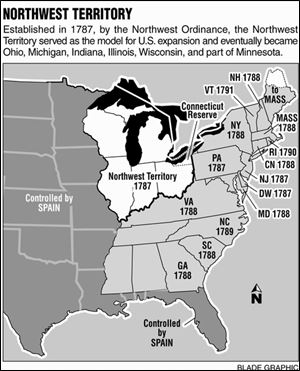
Territory offered springboard for western growth
3/2/2003Long before the Oregon Trail, the California gold rush, St. Louis' claim as “Gateway to the West,” or Horace Greeley's famous utterance “Go West, Young Man,” the Ohio Country was the West.
The 13 colonies of a young America extended only halfway from the East Coast toward the Mississippi River. The Ohio River served as the entry point to what was considered the western lands, bordered on the east by Pennsylvania, on the south by the Ohio River, to the west by the Mississippi River, and to the north by Canada.
By the late 1780s, this region had become known as the Northwest Territory.
The settling of this region played an important role in the future westward expansion of America.
“Ohio was unique in that it was the first one to be settled or be carved out,” said Irene Martin, preservationist at the Toledo-Lucas County Public Library.
The territory had been the home of Native Americans and later was controlled by the French, and then the British. The French relinquished their claim after their coalition with the Native Americans was defeated by the British and American colonists. The terms of the Treaty of Paris in 1763 effectively ended France's North American presence and the British took control of the western lands.
Prior to the Revolutionary War, four colonies — New York, Connecticut, Virginia, and Massachusetts — had claims going back to the late 1600s on various western lands.
Among Connecticut's holdings were about 3 million acres in northern Ohio east of present-day Sandusky. Dubbed the Connecticut Western Reservation, the Western Reserve, or “New Connecticut,” the state eventually sold most of the land to speculators who formed the Connecticut Land Co.

The western part, about 500,000 acres in present-day Huron and Erie counties, eventually was given to Connecticut citizens whose homes were burned by the British in the Revolutionary War. Because of this, the lands became known as the “Fire Lands” or “Sufferers Lands.”
In 1780, before the war was over, the Continental Congress took the extraordinary step of presuming victory and secured by resolution the western lands for future development into states.
It was not until July 13, 1787 — when the Congress of the Confederation approved the Northwest Ordinance — that the Northwest Territory was created. This act established a territorial government and set up policies that would allow the country to expand westward. Marietta was the first capital of the Northwest Territory. Later, Cincinnati and Chillicothe had that distinction.
“For the first time in the modern world, a republican nation decided on its own initiative to convert a colonial region into an integral part of itself. The ‘colonies' were to be regarded as extensions of the mother country, a dependent wilderness area would become independent, republican states on a basis of equality with the existing states,” wrote George W. Knepper in Ohio and its People.
These lands, still undeveloped, unsettled, and home to numerous tribes, were not ready for statehood. But they were organized into a territory while plans for future states were developed. However, some significant problems remained. Congress needed to get the four states that owned the western lands to turn them over to the federal government, which they all did by 1786.
Land titles from Native Americans also had to be obtained and were done so through wars, coercion, and eventually, treaties. Despite their defeat in the Revolutionary War, the British retained a presence in the western lands, establishing several posts such as Fort Detroit and Fort Miami, in present-day Maumee.
Despite these problems, which lingered into the next century, the Confederation Congress moved in the mid-1780s to enact its plan.
The Land Ordinance of 1785 laid the foundation for the country's public land system and thus was one of the country's most significant acts. The ordinance determined how future states would be plotted by survey and their lands sold.
The township system was born from the ordinance, and land in eastern Ohio was set aside to give to veterans of the Continental Army as payment for their service.
The 1787 Northwest Ordinance decreed that at least three and as many as five states would be carved out of the Northwest Territory. The ordinance outlined the borders, including what would eventually become Ohio (1803), Indiana (1816), Illinois (1818), Michigan (1837), and Wisconsin (1848). Part of present-day Minnesota also was a part of the territory. At least 60,000 inhabitants had to live in an area before it could become a state.
Ohio was 16 years away from statehood when the Northwest Ordinance was passed. Not until Gen. Anthony Wayne's victory over Blue Jacket and a confederation of Native Americans at Fallen Timbers in 1794 and the subsequent Treaty of Greenville in August, 1795, did settlers flock to the Ohio Country.
The eastern part of the Northwest Territory became Ohio, the 17th state, on March 1, 1803. It would be years before settlers reached into the swamplands of northwest Ohio and began to settle the area in earnest.